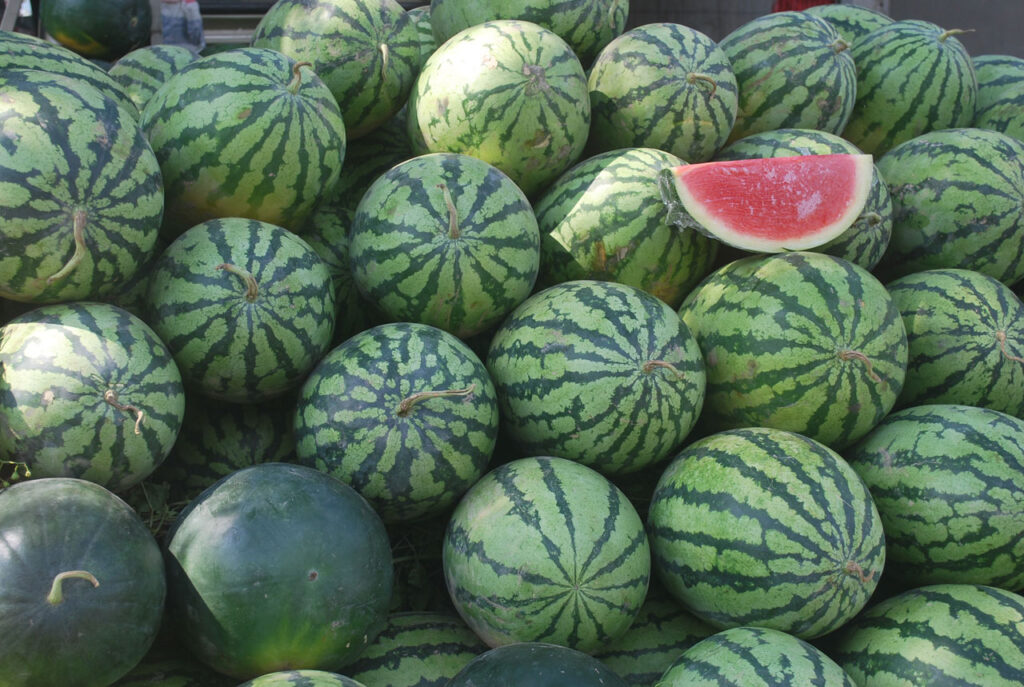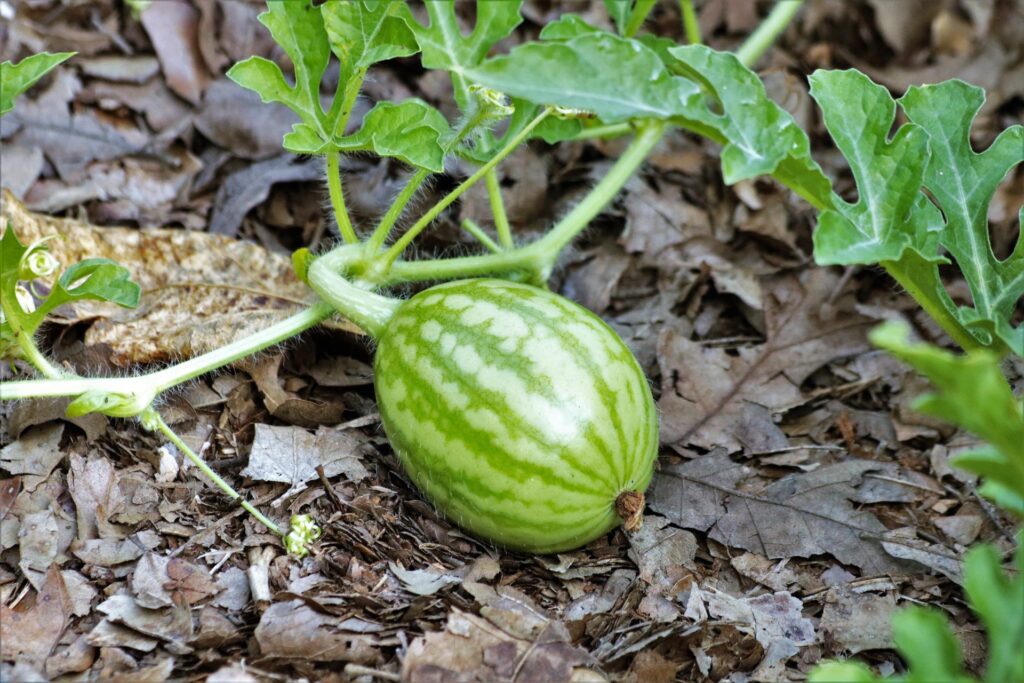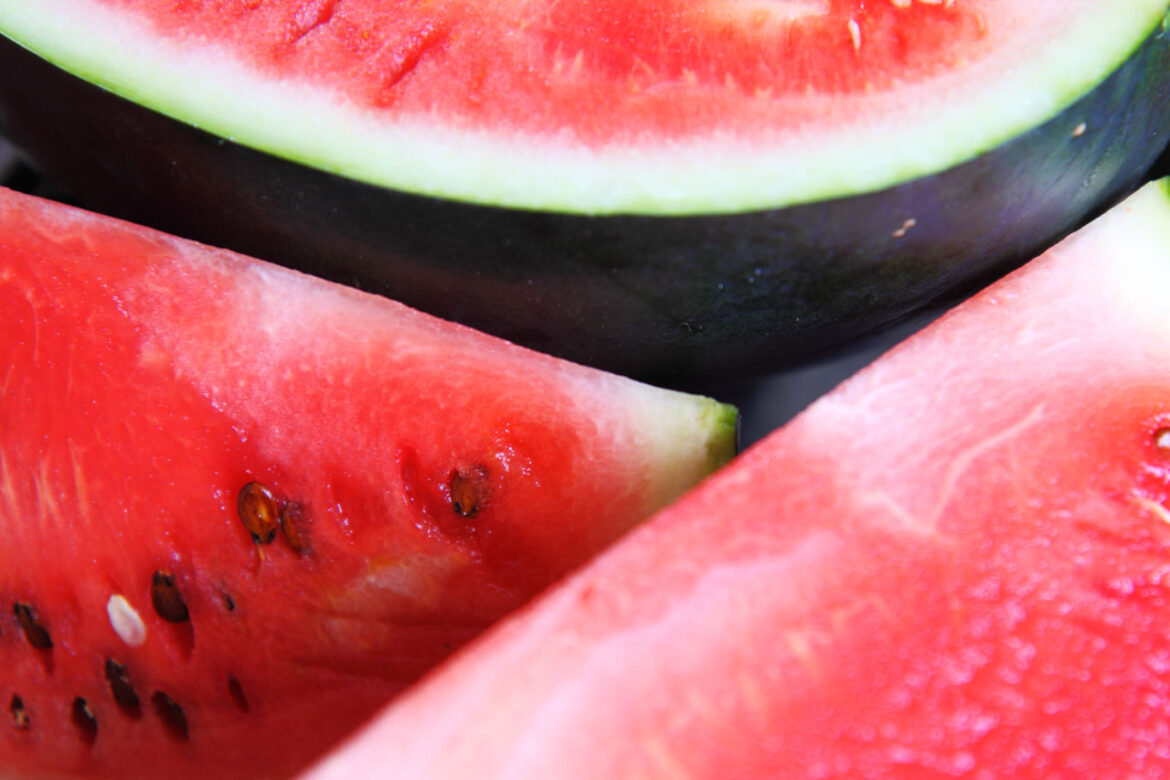Watermelons are a summertime treat enjoyed by young and old alike. There is nothing quite as refreshing as a cool slice of watermelon in the hot summer days of July and August. In addition to tasting great, watermelons are a leading source of lycopene (commonly found in tomatoes), in addition to being a very good source of vitamin A and C.
Where to Grow Watermelons
Because watermelons require a long, warm growing season, their best production in the United States occurs in the South and Southwest regions, where there is ample growing time and warm weather. Home gardeners in cooler regions can usually do fairly well with watermelons if they start seed indoors a month or more ahead of planting outdoors, but the vines need consistently warm days and nights to thrive. Watermelons need at least 80-100 consecutive days of very warm summer temperatures, at least 80 degrees Fahrenheit. Watermelons also prefer warm nights, above 70 degrees Fahrenheit is preferred. Watermelons are a warm-season crop, very tender to frost and light freezes. Plan an average of 2-6 plants per person. Watermelons generally take up enormous space, and should not be considered for the small vegetable garden. There are compact varieties that produce tasty and prolific fruits.
Recommended Varieties of Watermelons
The newer refrigerator-size small hybrid watermelons are more satisfactory for the average home garden, especially in the Northeast, where the growing season is shorter. Sugar Baby; New Hampshire Midget; and Lollipop.
Soil for Watermelon Growing
A sandy, light loam deeply enriched with manure and compost is ideal. The soil should be slightly acidic, pH 6. Since the vines are generally planted in hills, better yields can be realized by working in a spade full of well-rotted manure and fertilizer such as bone meal into each hill before planting. A well-finished compost would also be a good substitute. In the past, we have layered both green and brown garden wastes into a small mound and covered that with dirt to make a miniature compost mound. After one year, this mound makes an ideal place to plant your watermelons. As a side note: melon rinds are excellent compost material and would make a good base for such a mound.
| Temperature | |
| Germination | 75 - 95 F |
| For growth | 65 - 75 F |
| Soil and Water | |
| Fertilizer | Heavy feeder. Before planting, work in compost or rotted manure |
| Side-dressing | Apply balanced fertilizer or compost when vines are 12-18" long and again when fruits form. |
| pH | 6.0 - 6.5 |
| Water | Average |
| Measurements | |
| Seed Planting Depth | 1/2" |
| Root Depth | shallow in general , some up to 4' |
| Height | 24" |
| Width | up to 30 - 40 square feet. |
| Space between plants | |
| In Beds | 2' |
| In Rows | 4 - 8' |
| Space Between Rows | 5 - 7' |
| Average plants per person | 2 - 6 |
| Harvest | |
| Determining when a watermelon is ripe is more of an art than a science. Look for dark appearance overall and a golden yellow spot where the rind was resting on the ground for the most reliable indication of ripeness. | |
| First Seed Starting Date: | 18 days before last frost date |
| Last Seed Starting Date: | 112 - 151 Days before first frost date |
| Companions | |
| Companions | Pumpkins, radish, squash |
| Incompatibles | None |
Planting Watermelons
Germination in 7-10 days.
When –
To get a head start on the long growing season, start plants indoors 4 to 5 weeks before outdoor planting time. The soil must be warm and the weather settled with warm days and nights, as the plants are sensitive to cooler weather. If nights are cool, use hot caps to protect the plants. Melons can be sown directly outside, but some gardeners report better germination with pre-sprouted seeds.

Note on Seedless Watermelons:
Seedless watermelon seeds are notoriously difficult to germinate, which is the primary reason for their high cost. Direct seeding of seedless watermelon seeds will suffer a very low germination rate, they will almost certainly need to be transplanted. A soil thermometer is critical, and likely a thermostatically controlled heating mat necessary to maintain the soil temperature at the required 85 to 95 degrees F; seeds will germinate quicker at the higher temperature range. The most common reason for failure is too much water in the soil. Water should not be able to be squeezed out of a hand full of soil (too much water), and it should not fall apart in your hands (too little water). Rather, the soil should retain its shape in your hand after squeezing if the proper amount of moisture is present. This is critical for the first 48 hours. Once germinated, temperatures should be returned to temperatures that are representative of their growing environment. Expect seedlings to be less vigorous than standard seeded varieties, and slightly more susceptible to disease. Seedless watermelons will also require cross germination with a seeded watermelon variety in order to produce seedless watermelon fruit. A couple of germination seeds are often included in seedless watermelon packets. Any seeded variety can be used, the ones included are typically just for convenience.

How –
If you start melons indoors, use individual cells or peat pots, not flats, as the roots are too succulent to divide. When you direct sow, plant 2-3 seeds in a hill and then thin the appropriate spacing, depending on whether you train them on a trellis or let them spread on the ground. For direct sowing and transplants, cover seedlings with hot caps to protect from frost, speed growth, and keep out pests. The vines do best if planted in hills. Rows and hills should be set 5 to 6 feet apart each way, with 2 or 3 plants per hill. Thin to the 2 strongest plants in a week.
How Watermelons Grow
Watermelons grow extensively broad, ground-hugging vines with soft, attractive foliage. The flowers appear quite suddenly, and it is interesting to watch the tiny melons start to develop after the flower petals drop. Watermelons have separate male and female flowers and are not wind-pollinated. They typically rely on insects for pollination (most likely bees) and will need your help if insect pollinators are insufficient.
Cultivating Watermelons
To encourage side shoots, when seedlings have 3 leaves, pinch off the growing end. When new side shoots have 3 leaves, pinch off the central growing area again. When fruits begin to form, pinch back the vine to two leaves beyond the fruit. Make sure fruits on a trellis are supported by netting or pantyhose, and fruits on the ground vines are elevated by empty pots to prevent disease and encourage ripening.
The vines are heavy feeders, and also need adequate moisture as they start to develop. Troughs near the plants can be flooded for effective watering. For fertilizer, give each hill about 1/2 cup of 5-10-5 fertilizer, liquid manure, or fish emulsion 3 weeks after planting, and again (if you can find the original hill) after flowers appear. Keep the hills well-watered up to the time fruit starts to fill out. Since weeding and cultivating are such problems with sprawling vine crops, black plastic or thick mulch proves an excellent aid to keeping weeds out, soil moisture in, and melons off the ground as they develop. The plastic mulch should be placed on the ground and anchored before planting, then central holes cut for the hills, with a few extra slits to let rain and hose water filter through. Plain cardboard and newspaper covered appropriately also work well in a smaller garden setting.
| Storage Requirements | ||
|---|---|---|
| Store fruits in a cool area. | ||
| Fresh | ||
| Temperature | Humidity | Storage Life |
| 35 - 55 F | 80 - 90% | 1 month |
| Preserved | ||
| Method | Taste | Shelf Life |
| Frozen | Good | 3 months |
Harvesting Watermelons
Knowing when to harvest watermelons is the most difficult part of growing them. They should be harvested at the peak of freshness for the best results. Waiting too long gives you nothing but a mealy mess. Not waiting long enough means you may have to throw an inedible treasure out to the chickens.
There are several methods to identify a ripe watermelon, most of which are not entirely accurate at best. Some say you should tap them and listen to the sound they make, some say to look at the small tail to determine its ripeness. The fact is, these are not reliable indicators for all watermelon varieties. The most reliable indicator of ripeness is the color. Ripe watermelons will have darker stripes and the spot the rind rests on will turn from white to golden yellow. Different varieties will darken to different degrees, but this will be your best indicator. If all else fails, plant a variety like Sugar Baby. Its green stripes darken to almost black when it is ripe, which makes the puzzle a little easier.
Watermelon Pests
- Striped cucumber beetle (East Coast) – or – Spotted cucumber beetle (West Coast): This is essentially the same pest, which changes its coat depending on which coast it chooses. Adults overwinter on garden debris, so good fall cleanup is the first step in control. Yellow sticky traps can also be used for cucumber beetles, but be aware they will also trap beneficial insects. In large plantings, perimeter trap crops of “Blue Hubbard” winter squash can be an effective control strategy, as this is one of their favorite plants. Nearby plantings of barrage may also suppress cucumber beetle populations.
- Squash bug -Handpick adults and leaves bearing eggs. If boards are placed between rows in the evening, these insects will hide under them and can be destroyed in the early morning by uncovering and killing them.
- Vine borers – These pests are usually not seen until the damage is done. Good fall cleanup to destroy overwintering eggs is important.
Watermelon Diseases
Grow resistant varieties.
